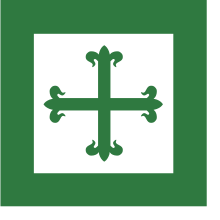Portuguese Legion (Estado Novo)
The Portuguese Legion ( Portuguese : Legião Portuguesa) was a volunteer militia of the authoritarian Estado Novo regime in Portugal. It existed from 1936 to 1974.
history
The fascism- friendly Estado Novo regime established in 1932 by Finance Minister Salazar , who has been in office since 1927, introduced two typically fascist mass organizations in 1936, which were received with some enthusiasm and anchored the regime in the population. In addition to the youth organization Mocidade Portuguesa , this was the Legião Portuguesa, a volunteer corps to protect the regime. However, the new organizations also provoked violent backlashes, including a temporarily (January 1934) successful, revolutionary general strike by the workers, and a military uprising by right-wing and monarchist elements that was thwarted by the police.
The Spanish civil war that broke out in 1936 was a major reason for this resistance by the workers, who were mostly anarcho-syndicalist organizations . The Estado Novo regime supported the fascist putschists of Franco , also with volunteers from the ranks of the Legião Portuguesa, but without daring to deploy a planned official Legion Viriato after massive resistance against it in the country. Meanwhile, the workers showed solidarity with the legitimate Republican government of Spain , and they perceived the new Legião Portuguesa in two ways as a hostile force of repression, both internally and externally, in the context of the consolidating fascism throughout Europe.
The Legião Portuguesa itself had initially formed spontaneously from volunteers who were friendly to the regime and who saw themselves on an “anti-Bolshevik crusade” and in defense of “the spiritual heritage of the nation”, including its first leader Teófilo Duarte . It was structured militarily and also had sea forces, armored vehicles and an intelligence service. The regime turned it into a paramilitary organization under its own direction. It was subordinated to the Ministry of the Interior and, in the event of war, to the Ministry of War. Initially, it acted as a collecting tank for fascist and ultra-right forces, which were then increasingly neutralized there from 1938 under the direction of Casimiro Teles. The Legião was now increasingly subordinated to the armed forces and could no longer form its own initiative. At the beginning of the Second World War, the Legião was the only major organization in the Estado Novo that was unreservedly on the side of the Third Reich , but from 1942 Salazar was increasingly able to commit it to civil protection and the suppression of political and social unrest in the country. From 1944 onwards, the Legião could be regarded as unreservedly loyal to the regime, and its own intelligence service structures were now harmonized with the state's secret services. A focus of the Legião later, especially since the 1950s and 1960s, was its nationwide network of informers and the support of the special forces deployed in demonstrations .
After the end of the Second World War in 1945, the Legião Portuguesa, like the Mocidade Portuguesa, was increasingly overtaken by the zeitgeist. The regime responded to the growing criticism with an additional reorientation, for example in civil defense. However, the measures were unsuccessful and met with increasing opposition from the population. Like the Mocidade Portuguesa, it was immediately dissolved in the course of the Carnation Revolution in 1974.
Individual evidence
- ↑ António Henrique de Oliveira Marques : History of Portugal and the Portuguese Empire (= Kröner's pocket edition . Volume 385). Translated from the Portuguese by Michael von Killisch-Horn. Kröner, Stuttgart 2001, ISBN 3-520-38501-5 , p. 559.
- ^ António Henrique de Oliveira Marques: History of Portugal and the Portuguese Empire. Kröner, Stuttgart 2001, ISBN 3-520-38501-5 , p. 580.
- ↑ ditto
- ↑ entry in the Pathfinder , the Internet Encyclopedia of Porto Editora , accessed on 16 March
- ^ António Henrique de Oliveira Marques: History of Portugal and the Portuguese Empire. Kröner, Stuttgart 2001, ISBN 3-520-38501-5 , p. 581.
- ↑ entry in the Pathfinder , the Internet Encyclopedia of Porto Editora , accessed on 16 March
